英语中六大从句用法总结
英语从句类型总结
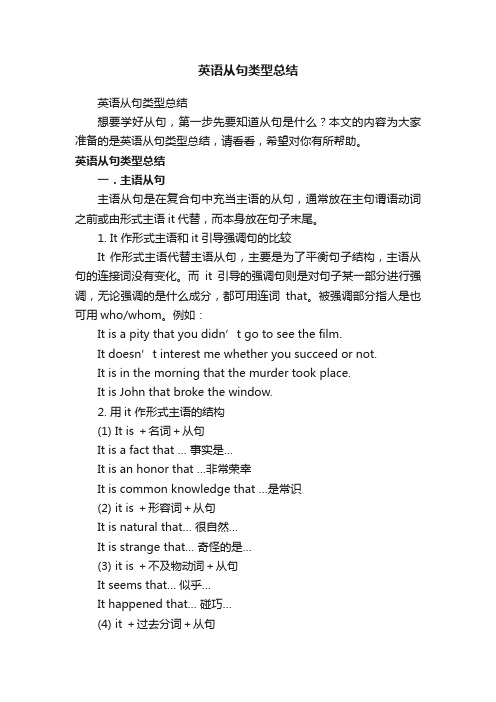
英语从句类型总结英语从句类型总结想要学好从句,第一步先要知道从句是什么?本文的内容为大家准备的是英语从句类型总结,请看看,希望对你有所帮助。
英语从句类型总结一.主语从句主语从句是在复合句中充当主语的从句,通常放在主句谓语动词之前或由形式主语it代替,而本身放在句子末尾。
1. It 作形式主语和it引导强调句的比较It 作形式主语代替主语从句,主要是为了平衡句子结构,主语从句的连接词没有变化。
而it引导的强调句则是对句子某一部分进行强调,无论强调的是什么成分,都可用连词that。
被强调部分指人是也可用who/whom。
例如:It is a pity that you didn’t go to see the film.It doesn’t interest me whether you succeed or not.It is in the morning that the murder took place.It is John that broke the window.2. 用it 作形式主语的结构(1) It is +名词+从句It is a fact that … 事实是…It is an honor that …非常荣幸It is common knowledge that …是常识(2) it is +形容词+从句It is natural that… 很自然…It is strange that… 奇怪的是…(3) it is +不及物动词+从句It seems that… 似乎…It happened that… 碰巧…(4) it +过去分词+从句It is reported that… 据报道…It has been proved that… 已证实…3. 主语从句不可位于句首的五种情况(1) if 引导的主语从句不可居于复合句句首。
(2) It is said , (reported) …结构中的主语从句不可提前。
英语从句知识点总结
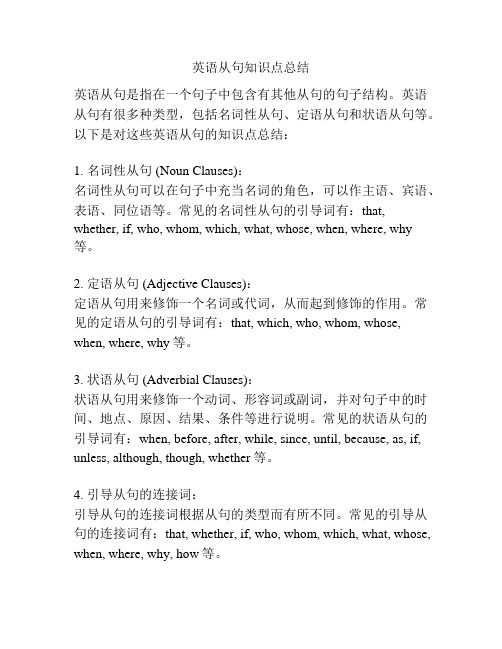
英语从句知识点总结英语从句是指在一个句子中包含有其他从句的句子结构。
英语从句有很多种类型,包括名词性从句、定语从句和状语从句等。
以下是对这些英语从句的知识点总结:1. 名词性从句 (Noun Clauses):名词性从句可以在句子中充当名词的角色,可以作主语、宾语、表语、同位语等。
常见的名词性从句的引导词有:that, whether, if, who, whom, which, what, whose, when, where, why等。
2. 定语从句 (Adjective Clauses):定语从句用来修饰一个名词或代词,从而起到修饰的作用。
常见的定语从句的引导词有:that, which, who, whom, whose, when, where, why等。
3. 状语从句 (Adverbial Clauses):状语从句用来修饰一个动词、形容词或副词,并对句子中的时间、地点、原因、结果、条件等进行说明。
常见的状语从句的引导词有:when, before, after, while, since, until, because, as, if, unless, although, though, whether等。
4. 引导从句的连接词:引导从句的连接词根据从句的类型而有所不同。
常见的引导从句的连接词有:that, whether, if, who, whom, which, what, whose, when, where, why, how等。
5. 从句的位置:从句可以出现在主句前面、中间或后面,具体的位置取决于从句的类型和句子的结构。
6. 省略从句的连接词:在某些情况下,从句的连接词可以省略,只保留从句的其他成分,例如主语、谓语等。
7. 从句的语序:从句的语序与主句的语序有所不同。
在陈述语序中,从句的语序和主句的语序一致;而在疑问语序中,从句的语序要倒装。
以上是英语从句的一些基本知识点总结。
英语中六大从句用法总结汇编

英语中六大从句用法总结1.主语从句1)主语从句可直接位于主语的位置,如果从句较长,谓语又较短,可用it作形式主语,而将从句放在句末。
常见的句型有:*It is a fact\a pity\a question\good news that...*It seems\appears\happened\has turned out that...*It is clear\important\likely\possible that...*It is said\reported\estimated\has been proved that...It is said that comic books create a connection between people of the same generation.It seems that the performance is very useful.2)what引导的主语从句表示“...的东西时”,一般不用it作形式主语。
What we lack is experience.3)what,who,when,why,whether等词含有各自的疑问意义,但它们引导的主语从句,都用陈述语序。
How the plan is to be carried out should be discussed again.I did know why I felt like crying.2.宾语从句1)宾语从句可位于及物动词、介词和某些形容词后。
连词that常可省略。
介词后一般接疑问词引导的宾语从句。
in that(因为),except that(除了),but that(只是)已构成固定搭配,其他介词后一般不接that引导的宾语从句。
*I promised that I would change the situation.*All this is different from what American young people would say about friendship.*He is certain that watching so much television is not good for children.*This article is well-written except that it is a bit too long.2)宾语从句后如有宾补,要用形式宾语it来代替,而把宾语从句移至宾补之后。
英语中六大从句用法总结(共5篇)
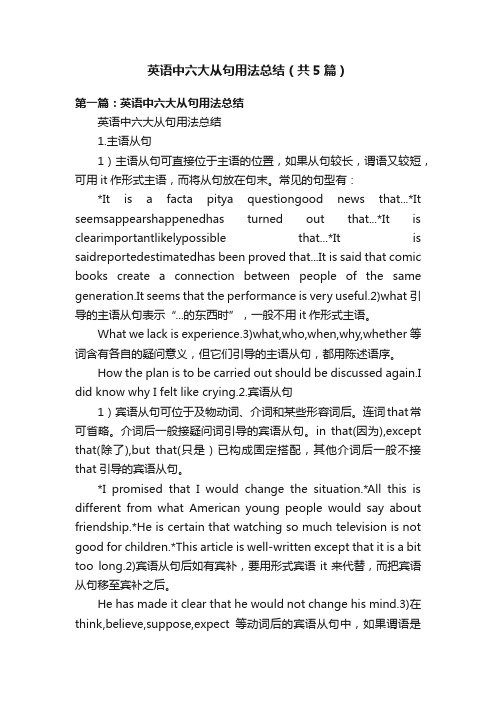
英语中六大从句用法总结(共5篇)第一篇:英语中六大从句用法总结英语中六大从句用法总结1.主语从句1)主语从句可直接位于主语的位置,如果从句较长,谓语又较短,可用it作形式主语,而将从句放在句末。
常见的句型有:*It is a facta pitya questiongood news that (I)seemsappearshappenedhas turned out that...*It is clearimportantlikelypossible that...*It is saidreportedestimatedhas been proved that...It is said that comic books create a connection between people of the same generation.It seems that the performance is very useful.2)what引导的主语从句表示“...的东西时”,一般不用it作形式主语。
What we lack is experience.3)what,who,when,why,whether等词含有各自的疑问意义,但它们引导的主语从句,都用陈述语序。
How the plan is to be carried out should be discussed again.I did know why I felt like crying.2.宾语从句1)宾语从句可位于及物动词、介词和某些形容词后。
连词that常可省略。
介词后一般接疑问词引导的宾语从句。
in that(因为),except that(除了),but that(只是)已构成固定搭配,其他介词后一般不接that引导的宾语从句。
*I promised that I would change the situation.*All this is different from what American young people would say about friendship.*He is certain that watching so much television is not good for children.*This article is well-written except that it is a bit too long.2)宾语从句后如有宾补,要用形式宾语it来代替,而把宾语从句移至宾补之后。
英语从句类型总结
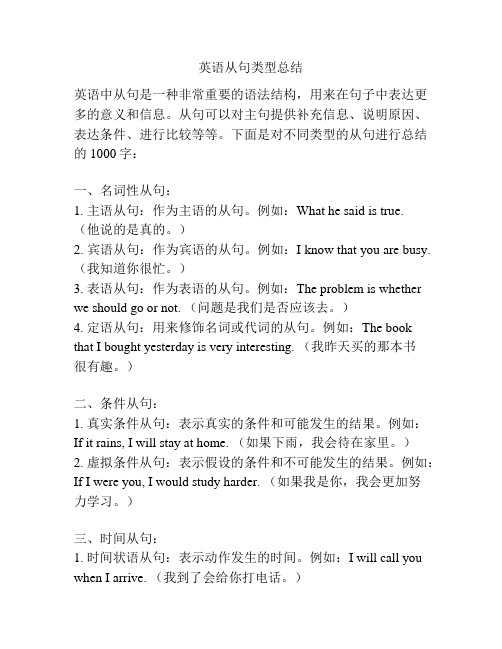
英语从句类型总结英语中从句是一种非常重要的语法结构,用来在句子中表达更多的意义和信息。
从句可以对主句提供补充信息、说明原因、表达条件、进行比较等等。
下面是对不同类型的从句进行总结的1000字:一、名词性从句:1. 主语从句:作为主语的从句。
例如:What he said is true.(他说的是真的。
)2. 宾语从句:作为宾语的从句。
例如:I know that you are busy. (我知道你很忙。
)3. 表语从句:作为表语的从句。
例如:The problem is whether we should go or not. (问题是我们是否应该去。
)4. 定语从句:用来修饰名词或代词的从句。
例如:The book that I bought yesterday is very interesting. (我昨天买的那本书很有趣。
)二、条件从句:1. 真实条件从句:表示真实的条件和可能发生的结果。
例如:If it rains, I will stay at home. (如果下雨,我会待在家里。
)2. 虚拟条件从句:表示假设的条件和不可能发生的结果。
例如:If I were you, I would study harder. (如果我是你,我会更加努力学习。
)三、时间从句:1. 时间状语从句:表示动作发生的时间。
例如:I will call you when I arrive. (我到了会给你打电话。
)2. 状语从句:表示伴随动作的时间。
例如:He is reading while waiting for the bus. (他在等车的时候看书。
)四、原因从句:1. 原因状语从句:表示动作的原因。
例如:I'm tired because I didn't sleep well last night. (我昨晚睡得不好,所以很累。
)2. 结果状语从句:表示动作的结果。
例如:He ran so fast thathe won the race. (他跑得太快,所以赢得了比赛。
英语中的六大从句
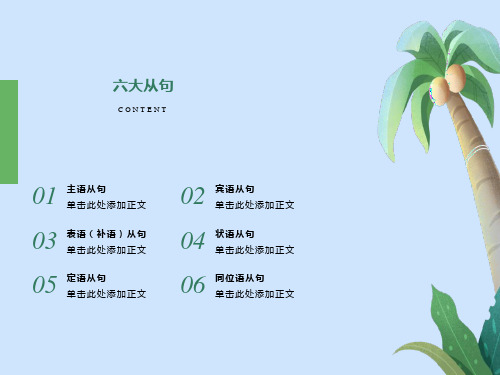
She asked me whether there would be any meeting in the afternhere he lives.
宾语从句
STEP2
STEP1
The problem is who can help him out of his difficulties.
e must remember the truth that a rolling stone gathers no moss.
he question of when and where the meeting is to be held hasn't yet been resolved.
同位语从句
01
主语从句
单击此处添加正文
03
表语(补语)从句
单击此处添加正文
05
定语从句
单击此处添加正文
02
宾语从句
单击此处添加正文
04
状语从句
单击此处添加正文
06
同位语从句
单击此处添加正文
六大从句
CONTENT
主语从句
1. Who damaged the computer is yet unknown. 2. How the thief managed to open the safe is being investigated by the police. 3. Whether Tony will come or not doesn't matter much. 4. It is not yet fixed when and where the meeting will be held. 5. It is strange that she should reject the invitation. 注意:主语从句作主语时谓语形式作单数处理。
英语从句用法小结

英语从句从句有主语从句、表语从句、宾语从句、同位语从句、定语从句和状语从句6类。
前四类由于主语从句、表语从句、宾语从句及同位语从句在句子的功用相当于名词,所以通称名词性从句;后两类定语从句和状语从句功用相当于形容词,称为形容词性从句。
状语从句还可以分为条件状语从句、原因状语从句、方位状语从句和时间状语从句。
1.主语从句(Subject Clause):用作主语的从句叫主语从句。
引导主语从句的关联词有从属连词、疑问代词、疑问副词、缩合连接代词、缩合连接副词等。
2.表语从句(Predicative Clause):用作表语的从句叫表语从句。
引导表语从句的关联词与引导主语从句的关联词大都一样。
3.宾语从句(Object Clause):在句子中起宾语作用的从句叫做宾语从句.宾语从句分为动词的宾语从句,介词的宾语从句和形容词的宾语从句。
一、主语从句★定义:主语从句时名词性从句中的一种,指句中的主语是一个完整的句子。
★位置:它可以放在主句谓语动词之前,但多数情况下由it作形式主语,而把主语从句放在主句之后。
★连词:引导主语从句的连词有that, whether, 连接代词有who, what, which, 连接副词有when, where, how, why等。
★例句:That she was able to come made us very happy.Whether she will come or not is still a question.What we need is more time.Who will go makes no difference.Which team will win the match is still unknown.When they will start is not known yet.Where she has gone is a mystery.How this happened is not clear.Why he did that wasn’t.★引导主语从句的that不作成分,但不能省略。
从句的知识点总结
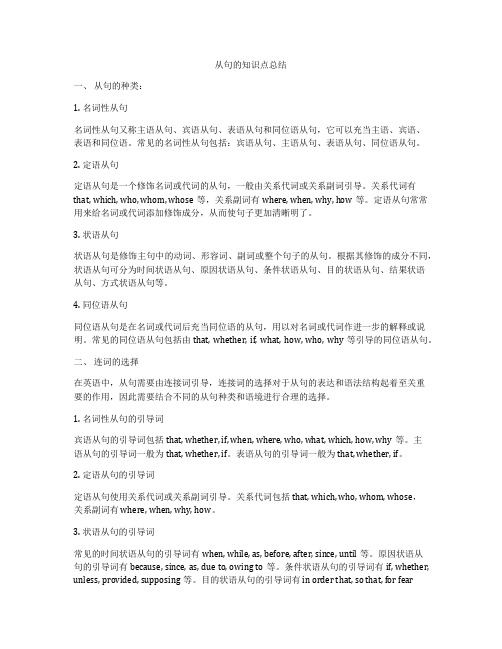
从句的知识点总结一、从句的种类:1. 名词性从句名词性从句又称主语从句、宾语从句、表语从句和同位语从句,它可以充当主语、宾语、表语和同位语。
常见的名词性从句包括:宾语从句、主语从句、表语从句、同位语从句。
2. 定语从句定语从句是一个修饰名词或代词的从句,一般由关系代词或关系副词引导。
关系代词有that, which, who, whom, whose等,关系副词有where, when, why, how等。
定语从句常常用来给名词或代词添加修饰成分,从而使句子更加清晰明了。
3. 状语从句状语从句是修饰主句中的动词、形容词、副词或整个句子的从句。
根据其修饰的成分不同,状语从句可分为时间状语从句、原因状语从句、条件状语从句、目的状语从句、结果状语从句、方式状语从句等。
4. 同位语从句同位语从句是在名词或代词后充当同位语的从句,用以对名词或代词作进一步的解释或说明。
常见的同位语从句包括由that, whether, if, what, how, who, why等引导的同位语从句。
二、连词的选择在英语中,从句需要由连接词引导,连接词的选择对于从句的表达和语法结构起着至关重要的作用,因此需要结合不同的从句种类和语境进行合理的选择。
1. 名词性从句的引导词宾语从句的引导词包括that, whether, if, when, where, who, what, which, how, why等。
主语从句的引导词一般为that, whether, if。
表语从句的引导词一般为that, whether, if。
2. 定语从句的引导词定语从句使用关系代词或关系副词引导。
关系代词包括that, which, who, whom, whose,关系副词有 where, when, why, how。
3. 状语从句的引导词常见的时间状语从句的引导词有when, while, as, before, after, since, until等。
英语八大从句类型与用法总结 有哪些从句
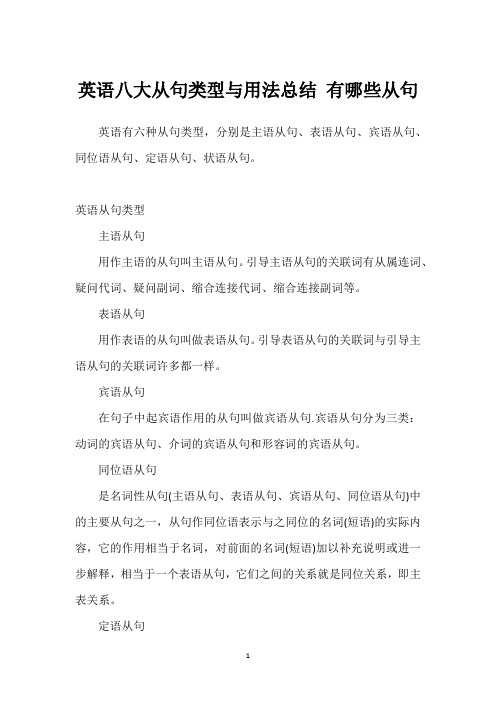
英语八大从句类型与用法总结有哪些从句英语有六种从句类型,分别是主语从句、表语从句、宾语从句、同位语从句、定语从句、状语从句。
英语从句类型主语从句用作主语的从句叫主语从句。
引导主语从句的关联词有从属连词、疑问代词、疑问副词、缩合连接代词、缩合连接副词等。
表语从句用作表语的从句叫做表语从句。
引导表语从句的关联词与引导主语从句的关联词许多都一样。
宾语从句在句子中起宾语作用的从句叫做宾语从句.宾语从句分为三类:动词的宾语从句、介词的宾语从句和形容词的宾语从句。
同位语从句是名词性从句(主语从句、表语从句、宾语从句、同位语从句)中的主要从句之一,从句作同位语表示与之同位的名词(短语)的实际内容,它的作用相当于名词,对前面的名词(短语)加以补充说明或进一步解释,相当于一个表语从句,它们之间的关系就是同位关系,即主表关系。
定语从句是由关系代词或关系副词引导的从句,其作用是作定语修饰主句的某个名词性成分,相当于形容词,所以又称为形容词性从句,一般紧跟在它所修饰的先行词后面。
状语从句可分为:时间状语从句、地点状语从句、缘由状语从句、条件状语从句、目的状语从句、让步状语从句、比较状语从句、方式状语从句、结果状语从句。
英语从句用法1.主语从句1)主语从句可直接位于主语的位置,假如从句较长,谓语又较短,可用it作形式主语,而将从句放在句末。
常见的句型有:2)what引导的主语从句表示“...的东西时”,一般不用it作形式主语。
3)what,who,when,why,whether等词含有各自的疑问意义,但它们引导的主语从句,都用陈述语序。
2.宾语从句1)宾语从句可位于及物动词、介词和某些形容词后。
连词that 常可省略。
介词后一般接疑问词引导的宾语从句。
in that(由于),except that(除了),but that(只是)已构成固定搭配,其他介词后一般不接that引导的宾语从句。
2)宾语从句后如有宾补,要用形式宾语it来代替,而把宾语从句移至宾补之后。
英语中总共有六大从句-区分方法

英语中总共有六大从句,区分方法,用法,及例子如下:1.主语从句1)主语从句可直接位于主语的位置,如果从句较长,谓语又较短,可用it作形式主语,而将从句放在句末.常见的句型有:*It is a fact\a pity\a question\good news that...*It seems\appears\happened\has turned out that...*It is clear\important\likely\possible that...*It is said\reported\estimated\has been proved that...It is said that comic books create a connection between people of the same generation.It seems that the performance is very useful.2)what引导的主语从句表示“...的东西时”,一般不用it作形式主语.What we lack is experience.3)what,who,when,why,whether等词含有各自的疑问意义,但它们引导的主语从句,都用陈述语序.How the plan is to be carried out should be discussed again.I did know why I felt like crying.2.宾语从句1)宾语从句可位于及物动词、介词和某些形容词后.连词that常可省略.介词后一般接疑问词引导的宾语从句.in that(因为),except that(除了),but that(只是)已构成固定搭配,其他介词后一般不接that引导的宾语从句.*I promised that I would change the situation.*All this is different from what American young people would say about friendship.*He is certain that watching so much television is not good for children.*This article is well-written except that it is a bit too long.2)宾语从句后如有宾补,要用形式宾语it来代替,而把宾语从句移至宾补之后.He has made it clear that he would not change his mind.3)在think,believe,suppose,expect等动词后的宾语从句中,如果谓语是否定的,一般将否定词移至主句谓语上,宾语从句则变成肯定形式.He didn't think that the money was well spent.3.表语从句表语从句出现在结构为“主语+系动词+表语从句”的句子中.表语从句除可用that,what,when,why,whether,how等引导外,还可由because,as if(though)等引导.that 常可省略.如主句主语为reason,只能用that引导表语从句,不可用because.Perhaps the most important thing to remember is that there is no one common type of life in America.The reason why so many people died there is that there were not enough food supplies.It looks as if successful international cultural communication will make the world smaller.4.同位语从句同位语从句用于对前面出现的名词作进一步说明,一般用连词that引导,由于先行名词的意义不同,也可用whether,who,when,where,what,why,how等引导.常见的先行名词有fact,idea,belief,news,hope,conclusion,evidence,suggestion,order,problem,report,de cision.有时由于谓语较短,将同位语从句位于谓语之后.She finally made the decision that she would join the fashion show.I had no idea how many books I could borrow at a time.The news came that their team had won the championship.5.定语从句定语从句所修饰的先行词可以是名词或代词,也可以是一个句子.定语从句通常位于先行词之后,由关系代词或关系副词引导.*限制性定语从句限制性定语从句修饰先行词,对先行词起修饰作用,紧接先行词之后,无逗号,若省去,原句意思不完整.引导定语从句的关系代词有who,whom,whose,which,that等.who,whom,whose 用于指人,whose有时也可指物,相当于of which;which用于指物;that既可指人也可指物,但只用于限制性定语从句中.关系代词除了引导定语从句,替代先行词外,还在从句中担任主语、宾语、定语等.The computers and cables which make up the Internet are owned by people and organizations.Those who live alone or who are sick may have trouble in getting close to other people.The girl whose parents died in an accident is living with her grandmother.1)当先行词是all,anything,everything,something,nothing等不定代词或先行词前有first,last,any,few,much,some,no,only以及形容词最高级修饰时,只能用关系代词that引导从句.That is all that I've heard from him.He's the first person that I'm going to interview this afternoon.2)关系代词的省略在从句中作宾语的关系代词常可省略.关系代词紧跟介词,作介词宾语时不可用that,只可用which或whom引导从句,并且不可省略,但当介词位于宾语从句句末时,作为介词宾语的关系代词仍可用that,也可省略.This is one of those things with which we have to put up.This is one of those things (which\that) we have to put up with.3)引导定语从句的关系副词有when,where,why等.关系副词在从句中作状语,意义上相当于一个“介词+which”的结构.Even in comic books where(=in which) there are no words,the stories are fully expressed through the drawings.No one knows the reason why(=for which) he was so angry that day.5.定语从句*非限制性定语从句非限制性定语从句既可修饰先行词,也可修饰整个主句,起补充说明作用,与主句之间有逗号隔开,若省去,原句意思不受影响.不可用that引导非限制性定语从句.关系词不可省略. Every object has a gravitational pull,which is rather like magnetism.*“介词+which\whom\whose”引导的定语从句“介词+which\whom\whose”可引导限制性定语从句,也可引导非限制性定语从句,该结构中介词的选择取决于从句谓语动词的固定搭配,或先行词的习惯搭配.This is the computer on which he spent all his savingsIt is written by a person with whom we are all familiar.*as引导的定语从句as引导的定语从句主要用于“such...as”及“the same...as”的结构中,代替先行词是人或物的名词.as引导非限制性定语从句时,代替整个主句,从句可位于主句之前、之后或中间. These are not such problems as can be easily solved.(as代替先行词problems)As is mentioned above,no single company or group can control what happens on the Internet.(as代替主语)6.状语从句*时间状语从句引导时间状语从句的从属连词和词组有:1)when,whenever,while,as,after,before,since,till,until,once等.We have learnt quite a lot about it since we came here.2)as soon as,hardly(scarcely)...when,no sooner...than,each(every) time,the moment,immediately(that)等.As soon as I sent an e-mail message,I received positive responses.The moment he heard the good news,he jumped with joy.*地点状语从句引导地点状语从句的连词是where,wherever.Wherever she went,she took her little daughter with her.*原因、结果和目的状语从句1)引导原因状语从句的从属连词有:because,as,since,now(that),seeing that,considering that,in that等.Considering that he is a freshman,we must say he is doing well.2)引导结果状语从句的连词有:so...that,such...that,so that,that,so等.Mickey Mouse is so attractive that the children are reluctant to leave.3)引导目的状语从句的连词有:so that,in order that,for fear that,lest等,从句常使用may,might,can,could,would等情态动词.We got up early this morning so that we could catch the first bus to the railway station.*条件和让步状语从句1)引导条件状语从句的连词和词组有if,unless,as(so) long as,on condition that,in case,provided(providing) that,supposing等.As long as you have the right equipment,you can use a telephone line to transmit computer data.2)引导让步状语从句的连词和词组有though,although,whether,even though,even if,no matter what(when,how...),whatever(whenever,wherever,however.)等.though,even if 等引导状语从句可转换成含有as的部分倒装结构,具有强调意义.其结构为“形容词(副词、动词、名词)+as+主语+谓语”.No matter what you may say,I would not change my mind.Young as he is,he is quite experienced in this work.(=though he is young)Child as he is,he can speak English fluently.(=though he is a child)*方式状语从句引导方式状语从句的连词有as,just as,as if,as though等.as if,as though引导的状语从句中,谓语动词常用虚拟语气,表示与事实相反.The young man made the experiment just as the teacher had taught him.Everything went on as usual as if nothing had happened.。
从句的类型及用法总结

从句的类型及用法总结从句是语言中的一种基本成分,它可以扩展句子的信息量,并使句子更加具体和明确。
从句分为几种类型,包括名词性从句、形容词性从句和副词性从句。
本文将对这些从句的类型及其用法进行总结,并举例说明。
一、名词性从句名词性从句可以在句子中充当主语、宾语、表语或宾语补足语。
名词性从句通常由连接词“从属连词”引导,包括“that、whether/if、who、whom、whose、which、what”等。
1. 主语从句主语从句在句子中充当主语,常以“that、whether/if、wh-”为引导词。
例如:- That he has refused to help surprises me. (他拒绝帮助我,让我感到惊讶)- Whether she will come or not is still uncertain. (她是否会来还不确定) - What he said is true. (他说的是真的)2. 宾语从句宾语从句在句子中充当直接宾语或间接宾语,常以“that、whether/if、wh-”为引导词。
例如:- He knows that you are coming. (他知道你要来了)- I wonder if he can finish the task. (我想知道他是否能完成这个任务) - I don't know what he is talking about. (我不知道他在说什么)3. 表语从句表语从句在句子中充当表语,常以“that、whether/if、wh-”为引导词。
例如:- My wish is that you succeed. (我希望你成功)- The fact that he lied shocked everyone. (他撒谎的事实让每个人都感到震惊)4. 宾补从句宾补从句通常跟在某些动词(如“think、believe、find、consider”等)或介词(如“for、on、about”等)后面,充当宾语的补足语,常以“that、whether/if、wh-”为引导词。
从句的种类及使用方法
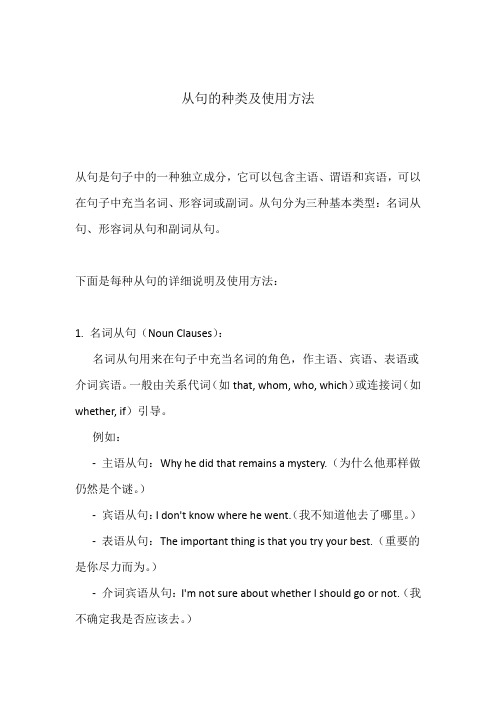
从句的种类及使用方法从句是句子中的一种独立成分,它可以包含主语、谓语和宾语,可以在句子中充当名词、形容词或副词。
从句分为三种基本类型:名词从句、形容词从句和副词从句。
下面是每种从句的详细说明及使用方法:1. 名词从句(Noun Clauses):名词从句用来在句子中充当名词的角色,作主语、宾语、表语或介词宾语。
一般由关系代词(如that, whom, who, which)或连接词(如whether, if)引导。
例如:-主语从句:Why he did that remains a mystery.(为什么他那样做仍然是个谜。
)-宾语从句:I don't know where he went.(我不知道他去了哪里。
)-表语从句:The important thing is that you try your best.(重要的是你尽力而为。
)-介词宾语从句:I'm not sure about whether I should go or not.(我不确定我是否应该去。
)2. 形容词从句(Adjective Clauses):形容词从句用来描述或修饰名词,通常由关系代词(如that, who, whom, which, whose)引导。
例如:- The book that I bought is on the table.(我买的书在桌子上。
)- He is the man who saved my life.(他是救了我命的人。
)3. 副词从句(Adverb Clauses):副词从句用来修饰动词、形容词或副词,并回答疑问词(如when, where, why, how, etc.)引导的问题。
例如:- When he arrived, everyone was already there.(当他到达时,所有人已经在那里了。
)- She speaks English better than I do.(她的英语说得比我好。
英语六大从句

从句有主语从句、表语从句、宾语从句、同位语从句、定语从句和状语从句6类.前四类由于主语从句、表语从句、宾语从句及同位语从句在句子的功用相当于名词,所以通称名词性从句;后两类定语从句和状语从句功用相当于形容词,称为形容词性从句.状语从句还可以分为条件状语从句、原因状语从句、方位状语从句和时间状语从句.1.主语从句(Subject Clause):用作主语的从句叫主语从句.引导主语从句的关联词有从属连词、疑问代词、疑问副词、缩合连接代词、缩合连接副词等.2.表语从句 Predicative Clause):用作表语的从句叫表语从句.引导表语从句的关联词与引导主语从句的关联词大都一样.3.宾语从句(Object Clause):在句子中起宾语作用的从句叫做宾语从句.宾语从句分为三类:动词的宾语从句,介词的宾语从句和形容词的宾语从句.第一部分一.、定义:宾语从句就是一个句子作动词或介词的宾语.二、学习宾语从句要抓住三要素:连接词、语序和时态.连接词一般都是that(指事务或人),which 指事),who 指人)1.从句为陈述句,常选择连接词that或将that省略,直接与主句相连.2.从句为一般疑问句,常选择连接词if或whether.在whether…or not结构中不能用if替换. 3.从句为特殊疑问句,常选择what,when,where,which,who,how等的疑问代、副词作连接词.★当who为主语时,句式为:who+谓语+其他判断时态情况:1.主句是一般现在时,从句为各种时态情况2.主句是一般过去时,从句为各种相应过去时态注意:从句描绘客观事实,用一般现在时3.主句是一般将来时,一般从句为一般现在时 “主将从现”)例题:〈1. The teacher told the children that the sun__B__round.A. wasB. isC. wereD. are 答案为B,属于第二种情况.宾语从句,在复合句中作宾语,位于及物动词后;Tell him which class you are in .(1)主、从句时态一致:主句谓语过去时,从句相应过去时;He answered that he was listening to me.主句谓语现在时,从句时态任所需;He says (that) he will leave a message on my desk.具体过去永不变,真理格言现在时;He told me that he was born in 1980.2)否定前移,及完成反意问句;在think / believe / suppose / guess / imagine / expect等动词后跟宾语从句否定式时,应转移到主句上去,完成反意疑问句时,应与从句主、谓保持一致.(注: 否定前移的条件是,主句主语是第一人称)I don't think you are right ,are you ?3)在表示建议suggest , advise要求demand 、desire、require、request、propose;决定decide; 命令order、command; 坚决主张insist;等动词后跟宾语从句,用 should)+v. 虚拟语气)eg.I suggested that you should)study hard.4)如果宾语从句后有宾语补足语,用it作形式宾语,把宾语从句后置eg.You may think it strange that he would live there.5)宾语从句that常可省略,但在以下情况下不能省略A.当主句谓语动词带有两个或两个以上宾语从句时,可以省略第一个that,其他不能省略. eg.I believe that)you have done your best and that things will get bet?鄄ter.B.当it作形式宾语时eg.She made it clear that she had nothing to do with him.C.当宾语从句前置时eg.That our team will win,I believe.三、分类A 、作动词的宾语:eg.I heard the newsI 主语heard 谓语动词the news.名词作宾语I主语heard 谓语动词that he would come here later on.一个句子作宾语---宾语从句B 、作介词的宾语:eg.He said nothing about this plan .He主语said 谓语动词nothing 代词作动词的宾语about 介词the plan. 名词作介词的宾语四、带有宾语从句的复合句的构成:带有宾语从句的复合句就是用连接词把一个主句和一个宾语从句连接在一起.连接词有:that(可省略),what, who, when, where, why, which, if, whether, how.五、注意:A 宾语从句必须用陈述语序.False: He is wondering when can he finish this difficult job.Right: He is wondering when he can finish this difficult job.B 有时候可以用it 作形式宾语,而把真正的宾语从句放在后面.Bad: I thought that he could finish this job in just two hours impossible.Good: I thought it impossible that he could finish this job in just two hours.Bad: He left whether we should continue this project to my judgment.Good: He left it to my judgment whether we should continue this project.C 带有宾语从句的复合句的否定形式一般是否定主句.Bad: I think he doesn’t like the English teacher.Good: I don’t think he likes the English teacher.D False: He wanted to know why he is crying in the corner.Right: He wanted to know why he was crying in the corner.4.同位语从句(Appositive Clause):与先行词同位或等同的从句叫作同位语从句.其关联词多为that.5.定语从句 Attributive Clause):用作定语的从句叫定语从句.定语从句一般皆放在被它所修饰的名 代)词之后,这种名 代)词就叫作先行词 Antecedent).引导定语从句的关联词为关系代词(或称引导词、关系词等).关系代词在定语从句中可用作主语、宾语、定语等;关系副词在定语从句中用作状语.①引导定语从句的关联词有who, whom, whose, that, when, where, why 和which. 在非限制定语从句中, 只可用which, who, whose, where , when., 如果指代前面整个句子, 多用which.例句:The dog that/which was lost has been found. 失踪的狗已经找到了.)③as 可做引导词引导定语从句, 多和such, the same 连用. As 引导的定语从句也可修饰整个句子, 既可放在先行词后,也可放在句子开头.例句:Such people as you describe are rare nowadays. 你描述的那一类人现在很少了.)④介词+which/whom/whose从句The driver is the man from whose room she had stolen the gold watch. 她就是从那个司机的房间偷了金表的.)⑤代/名+介词+which 从句He is needing a book, the name of which I don't know.( 他需要一本书,但是我不知道书名.)⑥同位语从句和定语从句The news that you told me was really exciting. 你告诉我的好个消息真的是很激动人心.)⑦难句:NO.1He is one of the men who were chosen to represent the group. 他是被选为代表该团队的人中一员.)第二部分一、时态1·主句用一般现在时,从句可用任意时态.2·主句用过去时,从句用过去某个时态.3·主句用过去时,从句是真理时,只用一般现在时.二、宾语从句的几类连接词:①从属连词连接宾语从句的从属连词主要有that,if,whether. that引导表示陈述句的宾语从句,而if和whether引导表示“是否”的宾语从句.例句:I don’t know if there will be a bus any more.我不知道是否还会有公交车.②连接代词连接代词主要有who, whom ,whose ,what ,whoever ,whomever ,whosever, whatever, whichever等.连接代词一般指疑问,但what, whatever除了指疑问外,也可以指陈述.例句:Do you know who has won Red Alert game?你知道谁赢了这一局红警游戏吗?③连接副词连接副词主要有when,where,why,how,whenever,wherever,however等.例句:He didn’t tell me when we should meet again.他没有告诉我什么时候我们能再见面.三、动词的宾语从句大多数动词都可以带宾语从句We all expect that they will win , for members of their team are stronger.我们都预料他们会赢,因为他们的队员更强壮.★部分“动词+副词”结构也可以带宾语从句例句:I have found out that all the tickets for the concert have been sold out.我发现这场音乐会的所有票都卖光了.★动词短语也可以带宾语从句常见的这些词有:make sure确保make up one’s mind下决心keep in mind牢记例句:Make sure that there are no mistakes in your papers before you turn them in.在上交试卷前确保没有任何错误.四、可运用形式宾语it代替的宾语从句①动词find,feel,consider,make,believe等后面有宾语补足语的时候,则需要用it做形式宾语而将that宾语从句后置.例句:I think it necessary that we take plenty of hot water every day .我认为每天多喝开水是有必要的.②有些动词带宾语从句时寻要在宾语与从句前加it这类动词主要有:hate, take , owe, have, see to.例句:I hate it when they with their mouths full of food.我讨厌他们满嘴食物时说话.③若宾语从句是wh-类,则不可用it代替例句:We all consider what you said to be unbelievable.我们都认为你所说的是不可信的.五、介词的宾语从句用wh-类的介词宾语从句例句:We are talking about whether we admit students into our club.我们正在讨论是否让学生加入我们的俱乐部.★用that,if引导的介词宾语从句有时候except,but,besides三个介词后可见到that引导的宾语从句例句:I know nothing about my new neighbor except that he used to work with a company.对于我的新邻居我只知道他曾在一家公司上班,其他一无所知.六、形容词的宾语从句常用来引导宾语从句的形容词有:sure,certain,glad,please,happy,sorry,afraid,satisfied,surprised例句:I am sure I will pass the exam.我确信我会通过考试.七、if,whether在宾语从句中的区别①if和whether在作“是否”解时,引导宾语从句常放在动词know,ask,care,wonder,find out等之后,介词后一般不用if②少数动词,如:leave,put,discuss,doubt后的宾语从句常用whether.③whether后可以加or not,但是if不可以.④在不定式前只能用whether.如:I can’t decide whether to stay. 我不能决定是否留下.⑤避免歧异时,我们常用whether而不用if.八、哪些宾语从句不可以省略引导词that1.当that作learn,suggest,explain,agree,wonder,prove,mean,state,feel,hold等动词的宾语时;2.当宾语从句较长时;3.当主语状语置于主句尾,宾语从句之前时;4.当主语谓语动词(包括非谓语动词)与宾语从句之间有插入语时;5.当一个动词带有两个或两个以上宾语从句时,此时第一个that可以省略,第二个that不可以省略;6.当宾语从句中的主语是this,that或this,that做主语的定语时;7.当宾语从句是双宾语中的直接宾语时;8.当宾语从句的主语是非谓语动词或主语从句时;9.当主语中的谓语动词是固定词组时;10.当宾语从句有it做其先行词时;11.在直接引语中,转述分句把宾语从句隔开时.九、宾语从句的否定转移主句的谓语动词是think,believe,imagine,suppose,consider,espect,fancy,guess等,并且主句的主语是第一人称而且为一般现在时,从句的否定词一般要转移到主句上来,其反义疑问句一般与宾语从句一致.例句:I don’t think he will come to my party.而不能说成I think he won’t come to my party.我认为他不会来我的舞会.★如果宾语从句中有某个含有否定意义的形容词或副词,其反义疑问句要用肯定形式.例句:We find that he never listens to the teacher carefully,does he?我们发现他从来不仔细听老师讲课,是不是?十、宾语从句的时态和语序当主句为现在时或将来时的时候,宾语从句的时态一般不受主句的时态所影响.当主句为过去时的时,细分为一下几种情况:①从句用一般过去时或过去进行时表示与主句谓语动词动作同时发生例句:I only knew he was studying in a western country,but I didn’t know what country he was in.我只知道他当时在西方的一个国家读书,可不知道是哪个国家.②从句过去完成时表示该动作发生在主句谓语动作之前例句:He told me that he had told Mary about the meeting already.他告诉我他已经把有关会议的事情告诉的了Mary.③从句谓语用过去将来时表示该动作发生在主句谓语动作之后例句:The reporter asked if the government would take necessary measures to put down the to-do.记者问政府是否会采取必要的措施镇压骚乱.★如果从句是一个客观真理,那么从句的时候不根据主句的时态而变化例句:The teacher said that the moon goes around the earth yesterday.老师昨天说月亮绕着地球转.★当宾语从句的引导词是who,which,what,when,where,how,why等表疑问时,不能按正常语序安排,经常将这类引导词置于句首例句:Who do you think the public might choose as their favorite singer this year?你认为今年公众会选谁为他们最喜欢的歌手.同位语从句用法比较"固定",把关键的几个词背下来 下面这个材料供参考):一、在复合句中用作同位语的从句叫同位语从句.它一般跟在某些名词后面,用以说明该名词表示的具体内容.如:I had no idea that you were here.我不知道你在这里.二、可以跟同位语从句的名词通常有news,idea,fact,promise,question,doubt,thought,hope,message,suggestion,words消息),possibility等.如:I’ve come from Mr wang with a message that he won’t be able to see you this afternoon.我从王先生那里来,他让我告诉你他今天下午不能来看你了.三、英语中引导同位语从句的词通有连词that,whether,连接副词how,when,where等.( 注:if,which 不能引导同位语从句.)如:l have no idea When he will be back.我不知道他什么时候回来.四、有时同位语从句可以不紧跟在说明的名词后面,而被别的词隔开. 如:The thought came to him that maybe the enemy had fled the city.他突然想起可能敌人已经逃出城了.五、同位语从句与定语从句的区别.1、同位语从句与前面的名词是同位关系,即说明它前面名词的内容;而定语从句与前面的名词是修饰与被修饰关系,即限定它前面的名词范围,或补充一些情况.如:The news that l have passed the exam is true.我通过了考试这一消息是真的.同位语从句,即从句所表达的意思就是前面名词的内容.)The news that he told me just now is true.他刚才告诉我的消息是真的.定语从句,从句对前面名词起修饰限制作用,即“他告诉我的”那个消息,而不是别的消息.)2、引导同位语从句的that是连词,在从句中不充当任何成份,而引导定语从句的that是关系代词,除起连接作用外,还在从句中充当主语、宾语或表语等.如:The idea that computers can recognize human voices surprises many people.计算机能够识别人的声音的想法使许多人感到惊奇.that在从句中不充当任何成份.)一个名词(或其它形式)对另一个名词或代词进行修饰,限定或说明,这个名词(或其它形式)就是同位语.同位语与被它限定的词的格要一致,并常常紧挨在一起.1) 非独立的同位语:常出现在被限定词前Bruce Lee (姓名) 李小龙Graf Schmidt (称号,浑名) 施密特伯爵Doktor Wang (职称,头衔) 王博士Uncel Liu (亲戚的称呼) 刘叔叔die Stadt Shanghai (类属名称) 上海市the Province Hebei (类属名称) 河北省das Jahr 2000 (类属名称) 2000 年three Kilo tomato (度量名称) 三公斤西红柿the University Bremen (专有名词) 不来梅大学。
英语六大从句用法总结
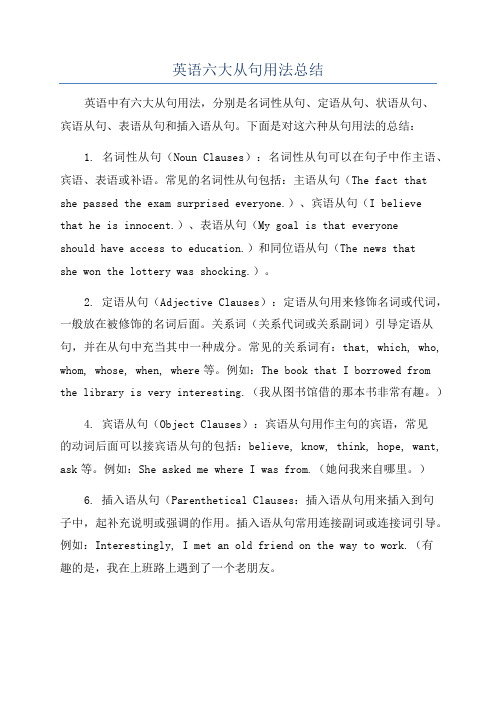
英语六大从句用法总结英语中有六大从句用法,分别是名词性从句、定语从句、状语从句、宾语从句、表语从句和插入语从句。
下面是对这六种从句用法的总结:1. 名词性从句(Noun Clauses):名词性从句可以在句子中作主语、宾语、表语或补语。
常见的名词性从句包括:主语从句(The fact that she passed the exam surprised everyone.)、宾语从句(I believe that he is innocent.)、表语从句(My goal is that everyoneshould have access to education.)和同位语从句(The news thatshe won the lottery was shocking.)。
2. 定语从句(Adjective Clauses):定语从句用来修饰名词或代词,一般放在被修饰的名词后面。
关系词(关系代词或关系副词)引导定语从句,并在从句中充当其中一种成分。
常见的关系词有:that, which, who, whom, whose, when, where等。
例如:The book that I borrowed from the library is very interesting.(我从图书馆借的那本书非常有趣。
)4. 宾语从句(Object Clauses):宾语从句用作主句的宾语,常见的动词后面可以接宾语从句的包括:believe, know, think, hope, want, ask等。
例如:She asked me where I was from.(她问我来自哪里。
)6. 插入语从句(Parenthetical Clauses:插入语从句用来插入到句子中,起补充说明或强调的作用。
插入语从句常用连接副词或连接词引导。
例如:Interestingly, I met an old friend on the way to work.(有趣的是,我在上班路上遇到了一个老朋友。
完整版英语从句用法总结

It was a great achievement to complete a 24-story building in 10 months.
固定用法和译法: (1) It is +名词+从句 It is a fact that… 事实是…… It is good news that … ……是好消息 It is a question that … ……是个问题 It is common knowledge that … ……是常识 类似的名词还有:a pity,a wonder,surprise,no wonder等.
2.由连接代词who,that引导;
What we lack is experience. Who will go to the energy conference is not important.
3.由连接副词when,how,where,why引导;
How he manages to finish the job is of interest to us. Why he failed the english exam wasn't clear.
The problem is when we can get a pay rise.
结构:主语 + 连系动词(be,seem,look) + 句子作表语 (1) 从属连词that,whether, as, as if 等;
The trouble is that I have lost his address.
I insist that she (should) do her work alone.
The commander ordered that troops (should) set off at once.
英语各种从句的用法

英语中从句包括:名词从句、定语从句、同位语从句和状语从句.一、名词从句包括主语从句、宾语从句和表语从句.(一)主语从句考试重点:主语从句常用的连词的用法;it is desirable that引导的主语从句的用法.在句子中担当主语的是一个从句,这个从句就叫主语从句.主语从句可以由下列连词、连接代词和连接副词引导,且不能省略.连词:that,whether 连接代词:what,whatever,who,whoever等.连接副词:when,where,how,why1、由连词that,whether引导的主语从句.连词that,whether在主语从句中的作用只是引导主语从句,它在从句中不担任成分,不能省略,且由它们引导的主语从句,多用it做形式主语.(1)_____ was unimportant.A. Whether he enjoyed our dinner or notB. No matter how he enjoyed our dinnerC. If he enjoyed our dinnerD. What he enjoyed our dinner2)That the earth is round is true.(It is true that the earth is round.)地球是圆的,是个事实.2、由连接代词和连接副词引导的主语从句它们分别在从句中担任主语、宾语和状语,不能省略.注意翻译时不能把它们译为疑问句.由它们引导的主语从句,也可以用形式主语it引导.(1)Who let out the news remained unknown.(It remained unknown who let out the news.)谁泄露了那个消息仍旧无人知道.(2)When we’ll start is not clear.(It is not clear when we’ll start.)我们何时出发还不清楚.3、以连接代词what, whatever, whoever…引导的主语从句.What有时可以用来表示the thing which这种意思,引导从句,表示一样东西或一件事情.Who,whom,which,what,可以和ever构成合成词,和what一样引导从句,ever起强调作用.此类句子不能用形式主语it引导,它们在句子中担任成份,不能省略,语序为陈述句的语序.(1)_____ I saw was two men crossing the street.A. WhatB. WhomC. WhoD. That4、句型It is desirable (suggested, necessary, requested, ordered, proposed, urgent)+that+主语+should(可省略)+V(动词原形).(1)It’s urgent that a meeting _____ before the final decision is made.A. will be arrangedB. must be arrangedC. be arrangedD. would be arranged(二)表语从句考试重点:表语从句的基本用法;含有suggestion,proposal等词的表语从句的用法.1、在从句中做表语的从句叫表语从句.它位于主句中的系动词之后,常用的关联词和主语从句相同.(1)This is what he wants. 这就是他想要的东西.(2)The question is whether we can finish our work by tomorrow morning.问题是我们明天上午能否完成任务.2、用suggestion等词表示愿望、建议、命令等情绪时,用虚拟语气,从句中用should(可省略)+动词原形.(1)The general’s command was that the soldiers _____ their fort and carry out more important tasks.A. would leaveB. leaveC. leftD. have left(三)宾语从句考试重点:宾语从句用陈述句的语序;介词后面的宾语从句;suggest,insist,order,demand等动词后接宾语从句时,用虚拟语气;if和whether 的区别.1、宾语从句用陈述句的语序(1)Can you tell me _____ about the city that makes people love it so much?A. it is whatB. what it isC. what is itD. is it what2、介词后面的宾语从句(1)The people at the party were worried about Janet because no one was aware _____ she had gone.A. where thatB. of whereC. of the placeD. the place3、suggest,insist,order,demand等动词后作宾语时,表示欲望、建议、命令等时,用虚拟语气.①His mother insisted that he _____ the coat when going out.A. put onB. puts onC. to putD. putting on4、在下列情况下不能用if , 而用whether.后跟不定式:He didn’t tell me whether to go or stay. 他没有告诉我是走还是留下.前面有介词:He raised the question of whether we could find the necessary money.他提出我们能否筹集到必要的资金这个问题.引导主语从句:Whether they win or lose is all the same to me.他们胜利也好,失败也好,对我来说都是一样的.后面直接跟or not:I wonder whether I’ll catch the last bus or not.我不知道我能否赶上末班车.(四) 同位语从句常跟在fact,idea,news等名词的后面,通常用连词that引导.1、Would the news _____ he failed to pass the exam bother you?A. whichB. thatC. of whichD. on which2、I had no idea that you were here. 我没有想到你会在这里.如果同位语从句所修饰的先行词是suggestion,proposal等名词的时候,谓语动词用should+原形动词.should可以省略.1、My suggestion that we do the experiment again is accepted bythem.我的再做一次实验的建议被他们所接纳.2、His proposal that they(should)challenge the other groups to a friendly competition is praised by the teacher. 他提议他们和别的组挑战,来一场友谊竞赛.这个提议受到了老师的表扬.二、定语从句考试重点:限定性定语从句中关系代词的用法;关系副词when,where,why,引导的定语从句;带介词的定语从句;非限定性定语从句;“名词(代词)+介词+关系代词”引出,一般是非限定性定语从句.在复合句中起定语作用的从句叫做定语从句.定语从句分为两种:限定性定语从句和非限定性定语从句.注意关系代词和关系副词在从句中的应用.(一)关系代词who,whom,whose,which,that引导的定语从句1、The company official _____ I thought would be fired received a raise.A. whomB. whoeverC. whoD. of whom(二)关系副词when ,where, why, 引导的定语从句1、The time will come _____ man can fly to outer space freely.A. thatB. whenC. in thatD. which(三)关系代词前带介词的定语从句1、Before her marriage, she spent a considerable time in that very part of Shanghai, _____ she belonged.A. whichB. to whereC. to whichD. at which(四)非限定定语从句对被修饰的名词起附加说明,或进一步描述或补充.这种从句有一定的独立性,即使去掉,主句的意思仍然完整,只是内容相对地不够具体.与主句之间常用逗号分开,所用的关系代词与限定性定语从句基本相同,但不能用关系代词that 引导.(1)An Old friend from abroad, _____I was expecting to stay with, telephoned me from the airport.A. thatB. whomC. whoD. which (五)“名词(代词)+介词+关系代词”引出,一般是非限定性定语从句.We’ve tested three hundred types of boot, _____is completely water proof.A. no of whichB. none of whichC. some of whichD. neither of which 考试重点:同位语从句的基本用法;含有suggestion,proposal等词的同位语从句.三、状语从句在主从句中起状语作用的从句叫状语从句.常见的状语从句有时间、地点、条件、原因、让步、方式、比较、目的、结果.考试重点:状语从句的种类及一些连词的基本用法;让步状语从句;unless,supposed (that),whomever,whenever,wherever等连词的含义和用法.一)时间状语从句常用的连词有:when,whenever(无论什么时候),since,as,until,hardly…when,no sooner…than,as soon as,before,after,the moment,the minute(一…就…)1、No sooner had they got the goods covered up _____ it started raining hard.A. whenB. thanC. thenD. after二)条件状语从句常用if,unless(除非,如果不),as/so long as只要.1、_____ I’m mistaken, I’ve seen that man before.A. UnlessB. IfC. BecauseD. Provided三)、原因状语从句常用:because, as, since.如果表示必然的因果关系,一般用because引入;而since表示一种间接或附带的原因;用as 只是提一下.1、He cannot go to school because he is ill. 他因为生病不能上学.2、Everyone likes you as you are both kind and honest. 人人都喜欢你,因为你既和气,又诚实.四)让步状语从句常用though/although,as (尽管),even if/though,however,whatever,wherever,whoever,no matter how/what/who等.1、In short, _____ he lives, a man belongs to some society.A. whateverB. wheneverC. whicheverD. wherever2、_____, you must show your ticket to go into the cinema.A. No matter whoever you areB. Whomever you areC. Whoever you areD. No matter who are you五)方式状语从句常用as, just as, as if/though 等词.1、_____ was pointed above, this substance can be used as a substitute.A. ItB. ThatC. WhatD. As2、He talks as if he _____ everything in the world.A. knowsB. knewC. had knownD. would have known六)目的状语从句常用so that , in order that, lest (以免,以防), in case.1、I wrote it down _____ I should forget it.A. in caseB. in case ofC. in order thatD. for fear of2、I’ll give you my phone number, so that you can call me when you arrive here.我把我的电话号码告诉你,以便你到达这里后可以给我打电话.七)结果状语从句常用so…that, such…that They are _____ students that they all performed well in the nationwide examinations.专注于活动方案总结,小学初中高中试卷,可以编辑的文档,欢迎下载使用本文档来源网络,由于文档太多,审核有可能疏忽,如果有错误或侵权,请联系本店马上删除。
(完整版)英语语法英语从句完全汇总

英语语法: 英语从句完全汇总一.主语从句主语从句是在复合句中充当主语的从句,通常放在主句谓语动词之前或由形式主语it 代替,而本身放在句子末尾。
1. It 作形式主语和it引导强调句的比较It 作形式主语代替主语从句,主要是为了平衡句子结构,主语从句的连接词没有变化。
而it引导的强调句则是对句子某一部分进行强调,无论强调的是什么成分,都可用连词that。
被强调部分指人是也可用who/whom。
例如:It is a pity that you didn’t go to see the film.It doesn’t interest me whether you succeed or not.It is in the morning that the murder took place.It is John that broke the window.2. 用it 作形式主语的结构(1) It is +名词+从句It is a fact that …事实是…It is an honor that …非常荣幸It is common knowledge that …是常识(2) it is +形容词+从句It is natural that…很自然…It is strange that…奇怪的是…(3) it is +不及物动词+从句It seems that…似乎…It happened that…碰巧…(4) it +过去分词+从句It is reported that…据报道…It has been proved that…已证实…3. 主语从句不可位于句首的五种情况(1) if 引导的主语从句不可居于复合句句首。
(2) It is said , (reported) …结构中的主语从句不可提前。
例如:It is said that President Jingo will visit our school next week. (right)That President Jiang will visit our school next week is said. (wrong)(3) It happens…, It occurs…结构中的主语从句不可提前。
各类从句的构成及其用法

各类从句的构成及其用法从句是英语中的一种重要句子结构,它由一个主句和一个或多个从句组成。
从句可以起到修饰、补充或者限定主句的作用。
在英语中,有不同种类的从句,下面将介绍一些常见的从句类型及其用法。
1. 名词性从句:名词性从句可以在句子中担任主语、宾语或者表语的作用。
这种从句通常由特定的连词引导,如that, whether, if, who, which等。
例如:- 主语从句:What she said made me happy.(她说的话使我很开心。
)- 宾语从句:He asked me if I could help him.(他问我是否可以帮助他。
)- 表语从句:The problem is whether we can finish it on time.(问题是我们是否能按时完成。
)2. 定语从句:定语从句用来修饰主句中的名词或代词,并提供额外的信息。
这种从句通常由关系代词(who, whom, whose, which, that)或关系副词(where, when, why)引导。
例如:- 关系代词引导的定语从句:The book that I bought yesterday is very interesting.(我昨天买的那本书非常有趣。
)- 关系副词引导的定语从句:This is the place where we first met.(这是我们第一次见面的地方。
)3. 状语从句:状语从句可以用来表示时间、原因、条件、目的、结果、方式等。
这种从句通常由特定的连词引导,如when, because, if, so that, although等。
例如:- 时间状语从句:She will call you when she arrives.(她到达时会给你打电话。
)- 原因状语从句:I couldn't go to the party because I was busy.(因为我很忙,所以没能参加聚会。
英语中总共有六大从句区分方法

英语中总共有六大从句,区分方法,用法,及例子如下:1.主语从句1)主语从句可直接位于主语的位置,如果从句较长,谓语又较短,可用it作形式主语,而将从句放在句末.常见的句型有:*It is a fact\a pity\a question\good news that...*It seems\appears\happened\has turned out that...*It is clear\important\likely\possible that...*It is said\reported\estimated\has been proved that...It is said that comic books create a connection between people of the same generation.It seems that the performance is very useful.2)what引导的主语从句表示“...的东西时”,一般不用it作形式主语.What we lack is experience.3)what,who,when,why,whether等词含有各自的疑问意义,但它们引导的主语从句,都用陈述语序.How the plan is to be carried out should be discussed again.I did know why I felt like crying.2.宾语从句1)宾语从句可位于及物动词、介词和某些形容词后.连词that常可省略.介词后一般接疑问词引导的宾语从句.in that(因为),except that(除了),but that(只是)已构成固定搭配,其他介词后一般不接that引导的宾语从句.*I promised that I would change the situation.*All this is different from what American young people would say about friendship.*He is certain that watching so much television is not good for children.*This article is well-written except that it is a bit too long.2)宾语从句后如有宾补,要用形式宾语it来代替,而把宾语从句移至宾补之后.He has made it clear that he would not change his mind.3)在think,believe,suppose,expect等动词后的宾语从句中,如果谓语是否定的,一般将否定词移至主句谓语上,宾语从句则变成肯定形式.He didn't think that the money was well spent.3.表语从句表语从句出现在结构为“主语+系动词+表语从句”的句子中.表语从句除可用that,what,when,why,whether,how等引导外,还可由because,as if(though)等引导.that常可省略.如主句主语为reason,只能用that引导表语从句,不可用because.Perhaps the most important thing to remember is that there is no one common type of life in America.The reason why so many people died there is that there were not enough food supplies.It looks as if successful international cultural communication will make the world smaller.4.同位语从句同位语从句用于对前面出现的名词作进一步说明,一般用连词that引导,由于先行名词的意义不同,也可用whether,who,when,where,what,why,how等引导.常见的先行名词有fact,idea,belief,news,hope,conclusion,evidence,suggestion,order,problem,report,decision.有时由于谓语较短,将同位语从句位于谓语之后.She finally made the decision that she would join the fashion show.I had no idea how many books I could borrow at a time.The news came that their team had won the championship.5.定语从句定语从句所修饰的先行词可以是名词或代词,也可以是一个句子.定语从句通常位于先行词之后,由关系代词或关系副词引导.*限制性定语从句限制性定语从句修饰先行词,对先行词起修饰作用,紧接先行词之后,无逗号,若省去,原句意思不完整.引导定语从句的关系代词有who,whom,whose,which,that等.who,whom,whose用于指人,whose有时也可指物,相当于of which;which用于指物;that既可指人也可指物,但只用于限制性定语从句中.关系代词除了引导定语从句,替代先行词外,还在从句中担任主语、宾语、定语等.The computers and cables which make up the Internet are owned by people and organizations. Those who live alone or who are sick may have trouble in getting close to other people.The girl whose parents died in an accident is living with her grandmother.1)当先行词是all,anything,everything,something,nothing等不定代词或先行词前有first,last,any,few,much,some,no,only以及形容词最高级修饰时,只能用关系代词that引导从句. That is all that I've heard from him.He's the first person that I'm going to interview this afternoon.2)关系代词的省略在从句中作宾语的关系代词常可省略.关系代词紧跟介词,作介词宾语时不可用that,只可用which或whom引导从句,并且不可省略,但当介词位于宾语从句句末时,作为介词宾语的关系代词仍可用that,也可省略.This is one of those things with which we have to put up.This is one of those things (which\that) we have to put up with.3)引导定语从句的关系副词有when,where,why等.关系副词在从句中作状语,意义上相当于一个“介词+which”的结构.Even in comic books where(=in which) there are no words,the stories are fully expressed through the drawings.No one knows the reason why(=for which) he was so angry that day.5.定语从句*非限制性定语从句非限制性定语从句既可修饰先行词,也可修饰整个主句,起补充说明作用,与主句之间有逗号隔开,若省去,原句意思不受影响.不可用that引导非限制性定语从句.关系词不可省略. Every object has a gravitational pull,which is rather like magnetism.*“介词+which\whom\whose”引导的定语从句“介词+which\whom\whose”可引导限制性定语从句,也可引导非限制性定语从句,该结构中介词的选择取决于从句谓语动词的固定搭配,或先行词的习惯搭配.This is the computer on which he spent all his savingsIt is written by a person with whom we are all familiar.*as引导的定语从句as引导的定语从句主要用于“such...as”及“the same...as”的结构中,代替先行词是人或物的名词.as引导非限制性定语从句时,代替整个主句,从句可位于主句之前、之后或中间.These are not such problems as can be easily solved.(as代替先行词problems)As is mentioned above,no single company or group can control what happens on the Internet.(as 代替主语)6.状语从句*时间状语从句引导时间状语从句的从属连词和词组有:1)when,whenever,while,as,after,before,since,till,until,once等.We have learnt quite a lot about it since we came here.2)as soon as,hardly(scarcely)...when,no sooner...than,each(every) time,the moment,immediately(that)等.As soon as I sent an e-mail message,I received positive responses.The moment he heard the good news,he jumped with joy.*地点状语从句引导地点状语从句的连词是where,wherever.Wherever she went,she took her little daughter with her.*原因、结果和目的状语从句1)引导原因状语从句的从属连词有:because,as,since,now(that),seeing that,considering that,in that等.Considering that he is a freshman,we must say he is doing well.2)引导结果状语从句的连词有:so...that,such...that,so that,that,so等.Mickey Mouse is so attractive that the children are reluctant to leave.3)引导目的状语从句的连词有:so that,in order that,for fear that,lest等,从句常使用may,might,can,could,would等情态动词.We got up early this morning so that we could catch the first bus to the railway station.*条件和让步状语从句1)引导条件状语从句的连词和词组有if,unless,as(so) long as,on condition that,in case,provided(providing) that,supposing等.As long as you have the right equipment,you can use a telephone line to transmit computer data.2)引导让步状语从句的连词和词组有though,although,whether,even though,even if,no matter what(when,how...),whatever(whenever,wherever,however.)等.though,even if等引导状语从句可转换成含有as的部分倒装结构,具有强调意义.其结构为“形容词(副词、动词、名词)+as+主语+谓语”.No matter what you may say,I would not change my mind.Young as he is,he is quite experienced in this work.(=though he is young)Child as he is,he can speak English fluently.(=though he is a child)*方式状语从句引导方式状语从句的连词有as,just as,as if,as though等.as if,as though引导的状语从句中,谓语动词常用虚拟语气,表示与事实相反.The young man made the experiment just as the teacher had taught him.Everything went on as usual as if nothing had happened.。
英语从句用法总结

/yftd/ShowA rticle.asp?ArticleID=1150英语中六大从句用法总结1.主语从句1)主语从句可直接位于主语的位置,如果从句较长,谓语又较短,可用it 作形式主语,而将从句放在句末。
常见的句型有:*It is a fact\a pity\a question\good news that...*It seems\appears\happened\has turned out that...*It is clear\important\likely\possible that...*It is said\reported\estimated\has been proved that...It is said that comic books create a connection between people of the same generation.It seems that the performance is very useful.2)what引导的主语从句表示“...的东西时”,一般不用it作形式主语。
What we lack is experience.3)what,who,when,why,whether等词含有各自的疑问意义,但它们引导的主语从句,都用陈述语序。
How the plan is to be carried out should be discussed again.I did know why I felt like crying.2.宾语从句1)宾语从句可位于及物动词、介词和某些形容词后。
连词that常可省略。
介词后一般接疑问词引导的宾语从句。
in that(因为),except that(除了),but that(只是)已构成固定搭配,其他介词后一般不接that引导的宾语从句。
*I promised that I would change the situation.*All this is different from what American young people would say about friendship.*He is certain that watching so much television is not good for children.*This article is well-written except that it is a bit too long.2)宾语从句后如有宾补,要用形式宾语it来代替,而把宾语从句移至宾补之后。
- 1、下载文档前请自行甄别文档内容的完整性,平台不提供额外的编辑、内容补充、找答案等附加服务。
- 2、"仅部分预览"的文档,不可在线预览部分如存在完整性等问题,可反馈申请退款(可完整预览的文档不适用该条件!)。
- 3、如文档侵犯您的权益,请联系客服反馈,我们会尽快为您处理(人工客服工作时间:9:00-18:30)。
英语中六大从句用法总结1.主语从句1)主语从句可直接位于主语的位置,如果从句较长,谓语又较短,可用it作形式主语,而将从句放在句末。
常见的句型有:*It is a fact\a pity\a question\good news that...*It seems\appears\happened\has turned out that...*It is clear\important\likely\possible that...*It is said\reported\estimated\has been proved that...It is said that comic books create a connection between people of the same generation.It seems that the performance is very useful.2)what引导的主语从句表示“...的东西时”,一般不用it作形式主语。
What we lack is experience.3)what,who,when,why,whether等词含有各自的疑问意义,但它们引导的主语从句,都用陈述语序。
How the plan is to be carried out should be discussed again.I did know why I felt like crying.2.宾语从句1)宾语从句可位于及物动词、介词和某些形容词后。
连词that常可省略。
介词后一般接疑问词引导的宾语从句。
in that(因为),except that(除了),but that(只是)已构成固定搭配,其他介词后一般不接that引导的宾语从句。
*I promised that I would change the situation.*All this is different from what American young people would say about friendship.*He is certain that watching so much television is not good for children.*This article is well-written except that it is a bit too long.2)宾语从句后如有宾补,要用形式宾语it来代替,而把宾语从句移至宾补之后。
He has made it clear that he would not change his mind.3)在think,believe,suppose,expect等动词后的宾语从句中,如果谓语是否定的,一般将否定词移至主句谓语上,宾语从句则变成肯定形式。
He didn't think that the money was well spent.3.表语从句表语从句出现在结构为“主语+系动词+表语从句”的句子中。
表语从句除可用that,what,when,why,whether,how等引导外,还可由because,as if(though)等引导。
that常可省略。
如主句主语为reason,只能用that引导表语从句,不可用because.Perhaps the most important thing to remember is that there is no one common type of life in America.The reason why so many people died there is that there were not enough food supplies.It looks as if successful international cultural communication will make the world smaller.4.同位语从句同位语从句用于对前面出现的名词作进一步说明,一般用连词that引导,由于先行名词的意义不同,也可用whether,who,when,where,what,why,how等引导。
常见的先行名词有fact,idea,belief,news,hope,conclusion,evidence,suggestion,order,problem,report,decision.有时由于谓语较短,将同位语从句位于谓语之后。
She finally made the decision that she would join the fashion show.I had no idea how many books I could borrow at a time.The news came that their team had won the championship.5.定语从句定语从句所修饰的先行词可以是名词或代词,也可以是一个句子。
定语从句通常位于先行词之后,由关系代词或关系副词引导。
*限制性定语从句限制性定语从句修饰先行词,对先行词起修饰作用,紧接先行词之后,无逗号,若省去,原句意思不完整。
引导定语从句的关系代词有who,whom,whose,which,that等。
who,whom,whose 用于指人,whose有时也可指物,相当于of which;which用于指物;that既可指人也可指物,但只用于限制性定语从句中。
关系代词除了引导定语从句,替代先行词外,还在从句中担任主语、宾语、定语等。
The computers and cables which make up the Internet are owned by people and organizations.Those who live alone or who are sick may have trouble in getting close to other people.The girl whose parents died in an accident is living with her grandmother.1)当先行词是all,anything,everything,something,nothing等不定代词或先行词前有first,last,any,few,much,some,no,only以及形容词最高级修饰时,只能用关系代词that引导从句。
That is all that I've heard from him.He's the first person that I'm going to interview this afternoon.2)关系代词的省略在从句中作宾语的关系代词常可省略。
关系代词紧跟介词,作介词宾语时不可用that,只可用which或whom引导从句,并且不可省略,但当介词位于宾语从句句末时,作为介词宾语的关系代词仍可用that,也可省略。
This is one of those things with which we have to put up.This is one of those things (which\that) we have to put up with.3)引导定语从句的关系副词有when,where,why等。
关系副词在从句中作状语,意义上相当于一个“介词+which”的结构。
Even in comic books where(=in which) there are no words,the stories are fully expressed through the drawings.No one knows the reason why(=for which) he was so angry that day.5.定语从句*非限制性定语从句非限制性定语从句既可修饰先行词,也可修饰整个主句,起补充说明作用,与主句之间有逗号隔开,若省去,原句意思不受影响。
不可用that引导非限制性定语从句。
关系词不可省略。
Every object has a gravitational pull,which is rather like magnetism.*“介词+which\whom\whose”引导的定语从句“介词+which\whom\whose”可引导限制性定语从句,也可引导非限制性定语从句,该结构中介词的选择取决于从句谓语动词的固定搭配,或先行词的习惯搭配。
This is the computer on which he spent all his savingsIt is written by a person with whom we are all familiar.*as引导的定语从句as引导的定语从句主要用于“such...as”及“the same...as”的结构中,代替先行词是人或物的名词。
as引导非限制性定语从句时,代替整个主句,从句可位于主句之前、之后或中间。
These are not such problems as can be easily solved.(as代替先行词problems)As is mentioned above,no single company or group can control what happens on the Internet.(as 代替主语)6.状语从句*时间状语从句引导时间状语从句的从属连词和词组有:1)when,whenever,while,as,after,before,since,till,until,once等。
We have learnt quite a lot about it since we came here.2)as soon as,hardly(scarcely)...when,no sooner...than,each(every) time,the moment,immediately(that)等。
As soon as I sent an e-mail message,I received positive responses.The moment he heard the good news,he jumped with joy.*地点状语从句引导地点状语从句的连词是where,wherever.Wherever she went,she took her little daughter with her.*原因、结果和目的状语从句1)引导原因状语从句的从属连词有:because,as,since,now(that),seeing that,considering that,in that等。
